Kath's mother Joyce visits Chile

Caramor - sailing around the world
Franco Ferrero / Kath Mcnulty
Wed 12 Apr 2017 01:53
My mother Joyce was coming to Chile. This was Plan B. Plan A (a visit in December) had failed when she broke her femur. At last the bone was mended and her leg muscles had strengthened. Franco made me promise that I wouldn’t break her again (Day 2 in the Canaries we went on a walk, she fell and broke her arm), nor drag her through stinging nettles (The Wye Valley walk a few years ago). I assured him I would be on best behaviour and would endeavour to make her stay as comfortable as possible. First the logistics needed to be sorted out. We would visit the Central Valley, Conguillio and Valdivia. The distances are vast, could we manage on the buses or would a flight be better? At the bus station I enquired about night buses with Pullman, the most expensive company. Surely, for double the price, you should get double the service. The seats were the same three quarters reclining as with the other companies (which, incidentally, are the most comfortable buses I have ever been on anywhere in the world). I insisted, “But surely, Señora, for all that extra money, there must be something better?” “I wouldn’t know,” she answered. “I’ve never taken a Pullman bus in my life, I travel with other companies.” If a Pullman bus isn’t good enough for Pullman employees, then it isn’t good enough for me. (Mr. Pullman, if you ever read this diary, please consider introducing staff benefits, you’d be amazed what a difference happy staff make!) I caught the Andesmar bus to Santiago which would arrive at the city centre at the same time as my mother’s flight touched down. Depending on how long it took her to get through customs, she might have to wait for me. My email directions were clear: “When you come through into the arrivals hall, turn left and wait at the café.” A further complication was the hire car. An agent would be waiting for us with a sign with my name on it. Andesmar was late arriving in Santiago but it only took a few minutes to find the transfer bus to the airport. Each time the driver changed gears, the smell of grinding clutch permeated the cabin. At last the airport was in sight, by now I was really quite late. As the driver pulled away from the bus stop, the gears slipped and the bus came to a halt. We were done for, the clutch was cooked. “I’m very sorry about this, would you all mind walking the last 500m?” apologised the driver. The lady from the car hire firm was at Arrivals but hadn’t seen my mother. We waited. Suddenly she appeared, shuffling against the flow of the crowd, heading towards the luggage reclaim area. Joyce had been waiting for over an hour, in the café to the RIGHT of Arrivals. We laughed as I reminded her of the time in Liverpool when I had asked her to wait by Arrivals and eventually found her by the car park, when the parking attendant had kindly rung my mobile. The hire car was one of those great little machines that make 100km/h feel like you are going at the speed of light. A couple of hours later we checked into El Suizo, the café in Placilla run by Cecilia and Roger (from Zurich) which Julie, Angie, Franco and I had discovered by accident when we went to the wrong Villa Alegre. (see post The Wrong Villa Alegre, 17 Feb. 2017) Roger was away, building ‘lego’ houses in Santiago and we were welcomed by Cecilia, her teenage kids Valentina and Diego and the two ‘Workaway’ volunteers Lindsay and Chris from New York. It was lovely to be able to relax in the yard, under the shade of the vines and pluck a grape or two when peckish. For the next day I had a booked a tour of the Viu Manent vineyard, just down the road on the outskirts of Santa Cruz. Franco and I particularly like some of the wines they produce and by chance, we had met José-Miguel, the owner and manager, at the sailing club in Valdivia. The tour started at 10:30, we would have plenty of time to get sorted in the morning. Our leisurely start turned into a mad rush when we were gazumped for the bathroom (we hadn’t realised other people were using it). Eventually breakfasted and showered we were ready but time was moving on. First the car door wouldn’t unlock, then the car wouldn’t start. It is compulsory to drive with the headlights on in Chile, and I’d forgotten to switch them off, the battery was flat. Cecilia sprang into action and two minutes later her brother Luis had turned up with his car and jump-started mine. I could have hugged him. For some unfathomable reason, the car manufacturer has designed the car alarm so that it goes off permanently when the battery is low. The siren was still sounding as we drove down the road and disappeared around the corner. (Incidentally, no one tried to stop us ‘stealing’ the car.) The bookings manager at Viu Manent was very understanding. I don’t think he had really expected us at 10:30, Chileans rarely make it before 12. The great news was that we had time for a coffee before the next tour (I needed one).  Mother watching the sparrows playing in the eaves of the Viu Manent Café Viu Manent is a family affair and contrary to what our French friends led us to believe, the name doesn’t mean ‘old countryman’ in old French! ‘Viu’ was one family and ‘Manent’ the other. In hispanic cultures, the children take both the father and mother’s surnames. This is why Franco keeps being called Mr British. They assume ‘Ferrero’ is his mother’s maiden name as it comes first and the only other ‘name’ they can find on his passport is ‘British’, which they conclude, must be is father’s surname. 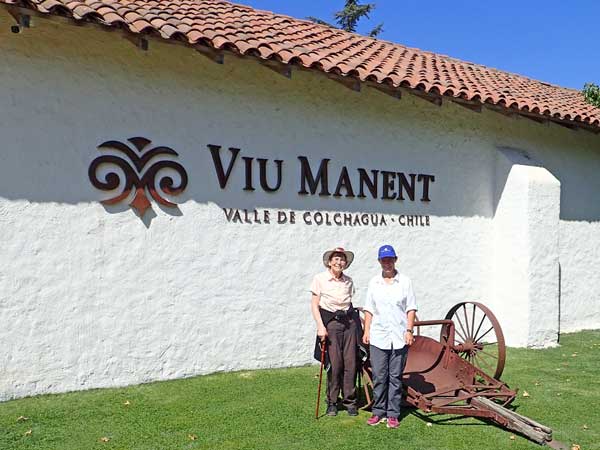 Joyce and Kath at Viu Manent It turns out great-grandfather Viu used to produce a drinkable table wine for the domestic market and the big change came about when our acquaintance José-Miguel took over. He improved the wine, expanded the vineyard and applied some very smart marketing. Today his main markets are the USA and China. The thing that fascinated me was the difference in soils and hydrology between the three vineyards which produce ‘single vineyard’ wines.  Single vineyard soil structure (from left to right): Malbec, Cabernet Sauvignon, Syrah The soil in the Malbec vineyard is formed from alluvial deposits and is irrigated by flooding. The Cabernet Sauvignon soil is alluvial deposits covered with volcanic ash and the Syrah is grown in a nutrient poor, free-draining podzol of volcanic origin. The last two are irrigated through a drip feed system. At noon, we joined our group; two ladies from Portugal, a couple from Brazil and a family from the States. He was from Chile, she from Guatemala and the kid swirled the water in his glass in the style of an expert wine connoisseur. Our guide, Nadia, gave an introduction and we all jumped onto a horse drawn carriage. Nadia’s explanations were so fascinating that I forgot to look around. Did you know that roses will deflect mildew attacks from the grapes? or that the juice of red and white grapes is clear (it is the skin that gives the colour to wine) except for a variety called ‘Alicante’ which has red juice? On the tour, we passed a laboratory with technicians in white coats. A reminder that wine these days is much more to do with science and chemistry than sunshine and earth. Whenever Franco and I open a bottle from the ‘Secreto’ range, we drink to the mad professors’ health, they’ve got the blend just right. I was driving so I left the drinking to my mother. 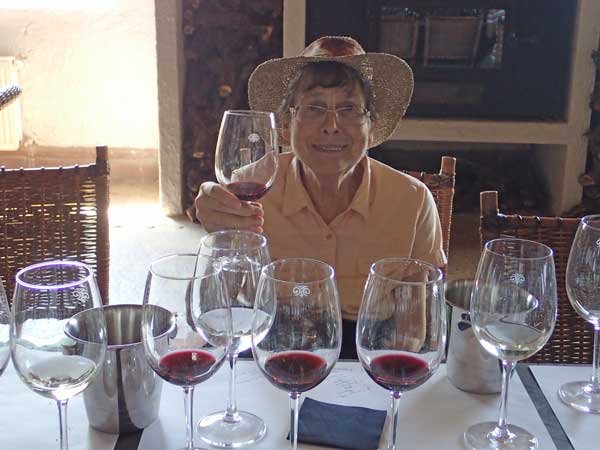 Mother Nadia explained the difference between Reserva and Gran Reserva. Under Chilean law, wine has to have an alcohol content of 11.5%. For a Reserva this increases to 12% and for a Gran Reserva to 12.5%. Of course it is how you achieve that additional alcohol content that matters. We tasted five different wines, all very palatable. The last was the single vineyard San Carlos Malbec. It was very smooth, maybe too smooth, for me. On the way out I bought a bottle of single vineyard El Olivar Alto Syrah 2013 and we are looking forward to sampling it back on Caramor. At the restaurant Joyce chose the chicken. The food was excellent but if the size of the chicken breasts is anything to go by, I wouldn’t want to visit a Chilean poultry farm, the hens must be bigger than me! We finished the day at the museum in Santa Cruz. This is a private collection owned by an international arms dealer and I had doubts about visiting. The fossils were the best I have ever seen and the quality of the exhibits second to none. If only public museums were as well financed. The next morning we rose at the crack of dawn. I was keen to avoid the bathroom pile up and hoped to catch the bus from Molina to the Siete Tazas National Park (see post A bit of a waterfall theme, 19 Feb. 2017). I was quite happy to delegate the driving along the terrible track to someone else. My excellent plan was to get to Molina (120km away) with plenty of time to spare, and enjoy breakfast in a nice café before catching the bus. Molina is a fairly large town with a fantastic Plaza de Armas (main square); enormous trees, fountains, a smart bandstand and comfortable benches. But cafés, there are none. The closest is a hotdog shop that serves N(o)-es-café. For a change I was delighted to find a modern supermarket, as it sold fresh buns and jam (bizarrely, Waitrose blueberry jam). “The daily bus to Siete Tazas? The next one leaves Friday evening, in two days’ time.” I was told at the bus station. Somehow, our little car made it up the rough track, though my mother wasn’t convinced all her bones were still in the right place at the end of the day.  La Vela de la Novia (‘the veil of the fiancée’) waterfall The main attraction in the Central Valley is vineyards, and although we had enjoyed our visit to Viu Manent, we didn’t particularly want to visit any others. The guidebook wasn’t forthcoming on other attractions so I scoured the map for inspiration. South-west of Placilla, not far from the coast was an interesting looking estuary, possibly a good place to watch birds. Cecilia confirmed it was worth going to and suggested we go through Lolol rather than along the Pichilemu road. The drive was pleasant and quiet. We passed through some of the areas that had been devastated by fires earlier in the summer. 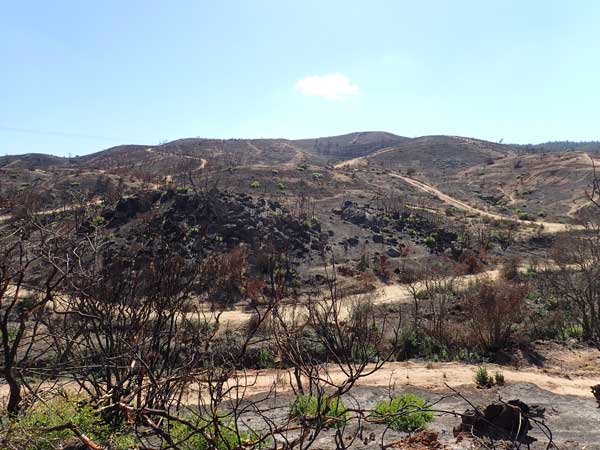 An area badly burnt This vast area is the coastal cordillera and is very dry and becoming increasingly so every year. We watched cattle grazing and wondered how they got enough nutrients as everything was parched. 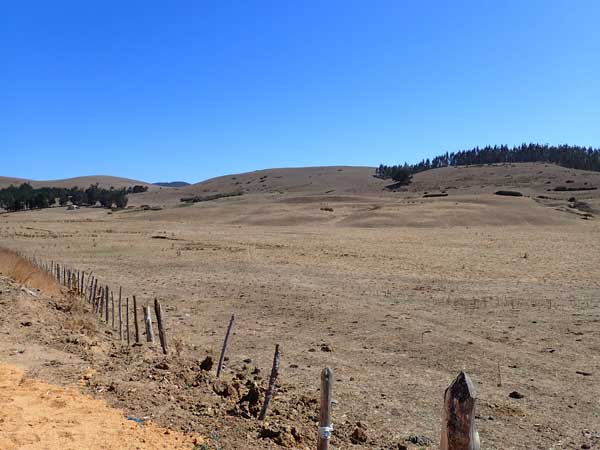 Farmland We stopped off for a drink in Bucalemu, a small resort on the Pacific Ocean before continuing on to the Cáhuil Wetland. It was rather beautiful and the bird life plentiful if quite a long way away. Salt was being extracted from the sea water and sold locally. Shallow ponds are created and connected to the sea by a short channel. The ponds are then flooded. Slowly the sun evaporates the water leaving behind a lining of salt crystals which can be raked up.  The Pacific 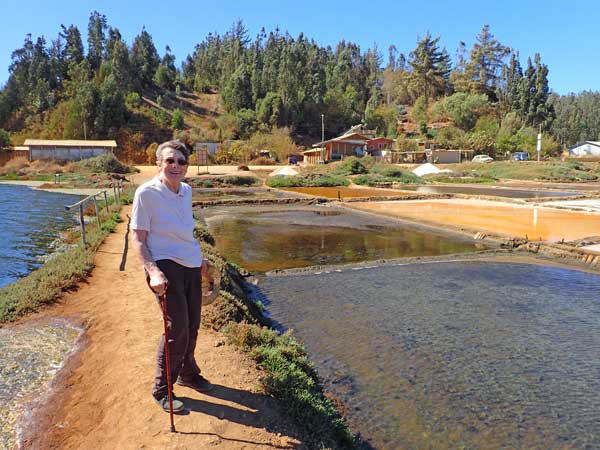 Joyce at Cáhuil  Working the salt ponds  Coscoroba swans 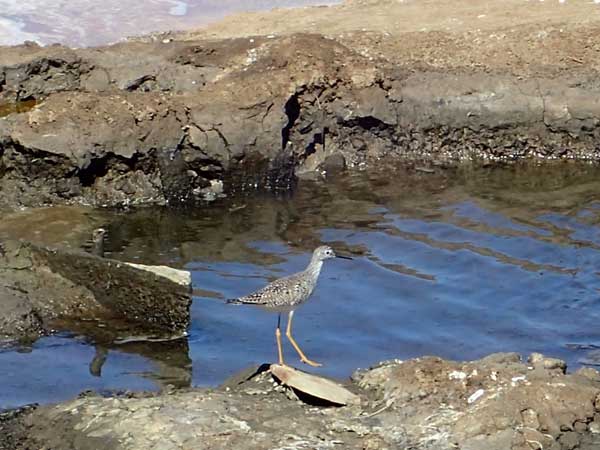 Pitotoy chico (Tringa flavipes) - I think We drove back through Pichilemu, the surf capital of Chile. Quite a few luxury surfer hotels have sprung up on the outskirts since my copy of the Rough Guide was published. Back at El Suizo we chatted with a lady who is helping new tourism ventures set up webpages. She recommended a riverside picnic spot on the Rio Claro where we would be able to walk along the river. “Alternatively, you could go to the Shangri-la Hotel for a nice lunch and walk from there,” she added. Most land in Chile is private, so you usually have to pay to visit a waterfall or sit by a river. Although this seems strange to us coming from Europe, I accept that everyone has to make a living. The problem is, outside of the holiday season, these places shut, there is no one to take the money and the tall fences and gates are padlocked. The Rio Claro was closed for business, the gates were locked and access to the river was impossible. 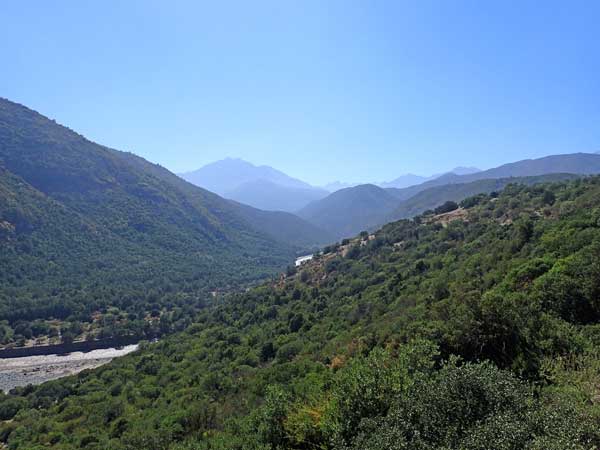 Looking towards the Andes We had passed the sign to Hotel Shangri-la, it looked very unassuming but the internet had sold me a luxury venue with hot baths, a nice restaurant and private walks along the river. “Shangri-la?” my mother smirked, “in Chile?” “Maybe it’s one of these über-posh places that plays down its image”, I said, dubiously. I drove down the steep track to the Chilean ‘earthly paradise’ but the place was as dead as a do-do. Eventually I found someone. “We’re shut for the winter,” he said. By now, we were very hungry. Heading back towards San Fernando, we passed a sign which read “Hoy, pastel de choclo”. (Today, maize pie) Pastel de choclo is a Chilean speciality and it seemed a good opportunity for Joyce to taste some. As we approached the store, a couple were sitting down to lunch. They were the owners, it was a butcher’s, not a restaurant. “It’s ‘take-away’ only,” said the lady. “You can heat it up for them,” said the man. “Please sit down.” It took a while but when it came it was very tasty. Marisol was concerned that the food was warm enough. It was, … except for a large chunk of chicken in the middle. My mother and I enjoyed a lovely afternoon chatting to our new friends. After a while their landlady joined us and we nattered on some more. 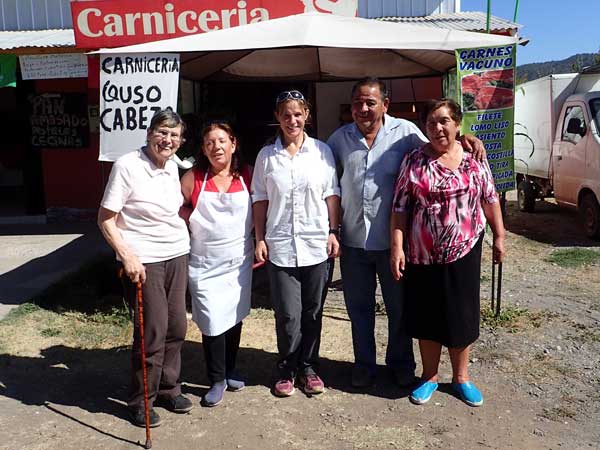 With our new friends Over the next few days we came to regret that pastel de choclo as my poor mum developed very funny belly. It was time to say goodbye to Cecilia and her family. She had looked after us well and had become a good friend. Since our little car didn’t go very fast and we had time, I decided to take the Ruta de la Fruta country road back to Santiago rather than follow the main motorway. Unfortunately public toilets were non-existent and we were very grateful to the lady in the small shop in Pataguas Cerro who let us use her bathroom. The car had to be returned with a full tank to the depot, near but not at the airport. Unfortunately in the last few miles, we didn’t pass a petrol station so I had to go looking for one. We then had to wait for the car hire firm to drive us to the airport. When we finally got there my heart sank at the sight of the huge check-in queue. “Would we make it in time?” I wondered. A few seconds later we were ushered to the front by the check-in attendant. Elderly people get priority. I’m going to start a business hiring grannies out for airport queues. I’ll make a fortune. The plane took off towards the clear blue firmament and landed an hour later through the thick autumn fog of Temuco. It felt like a different world. We picked up the hire car and met Franco at the B&B. The next morning, after visiting the Mapuche museum, we headed for a cabin in Conguillio National Park (see post Conguillio and the monkey puzzles, 22 Feb. 2017). The weather was dismal the whole time we were there but it didn’t stop us having a good time. 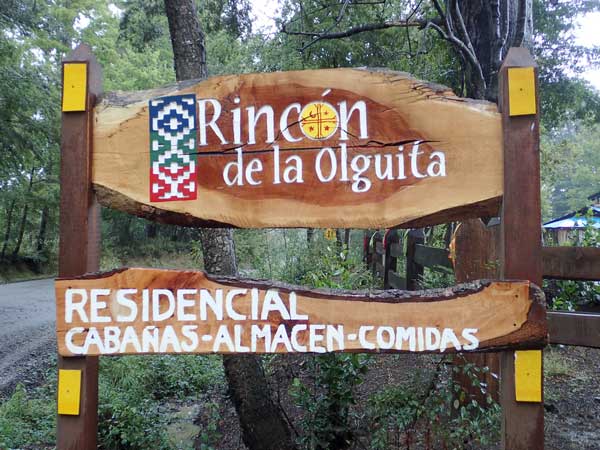 The place we stayed at 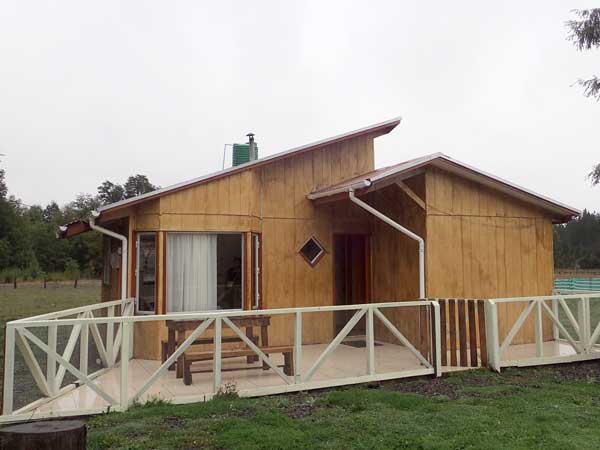 Our cabaña 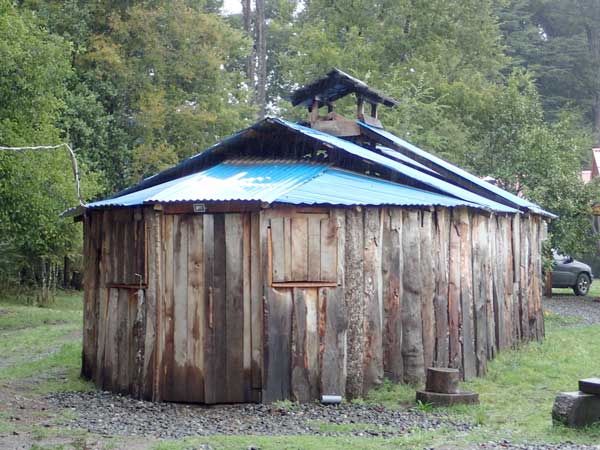 The small local shop, traditional Mapuche house style 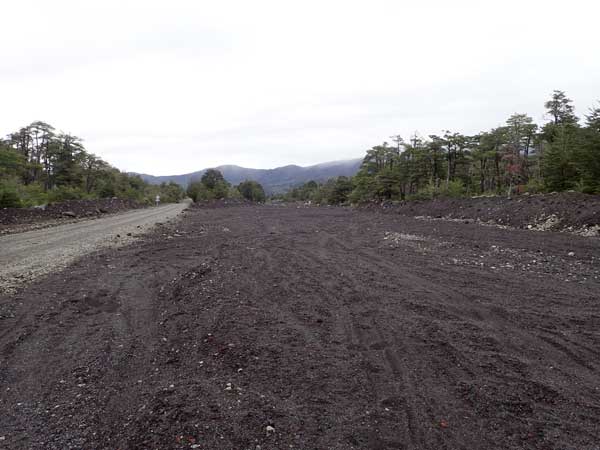 Pyroclastic flow from Volcan Llaima 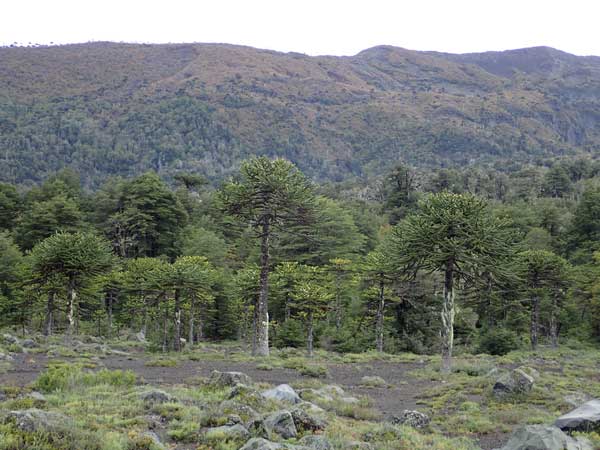 Conguillio monkey puzzle trees  A monkey puzzle tree that has been around several hundred years longer than Joyce and Kath  Salto del Indio  Wheat field in Araucanía On our last day in Araucanía, in a bid to get away from the rain, we drove west, over the main north-south Ruta 5 and on towards the sea. We were headed for Capitán Pastene. It was Jim, an American skipper in Puerto Montt who had told us about the place. He drives there once a year to eat proper Italian pasta. The road seemed to wind on forever. At a turn we picked up a lady hitchhiker. “All my family is in this village, I’m the only one who lives miles away, in Capitán Pastene,” she explained. She was delighted we were going there as she loves the place. She said that during the summer the fires had come really close to the village and the inhabitants had been frightened their homes would burn. “Who was Capitán Pastene?” I asked. She didn’t know. “Why did you move to Capitán Pastene?” I asked next. “For love, for a man. But he is dead now, he died a few months ago.” “I’m sorry.” I said. Aware that the conversation was starting to sound like what Franco would call ‘Kath’s Spanish Inquisition’, I shut up. The lady got out at Lumaco, the village before Capitán Pastene. My mother asked “Who was that lady? Did you know her?” “We’ve never met her, she was hitch-hiking. Kath just talks to anyone,“ explained Franco. At the next crossroads, Franco stopped to check that no traffic was coming and … a man jumped into the back seat. I was a little surprised but Franco seemed ok with it so I said nothing. It seems we had turned into the public bus. Later, Franco told me he thought we were being car-jacked, in a very civilised way. At the end of the 19th century, the municipality of Lumaco asked the president of Chile for a land concession to set up a new colony. Once granted, colonists were recruited in Italy and on 10 March 1904 the first 25 families reached Chile. A year later, a further 63 families made the journey. From the coast they travelled by train, then by horse drawn cart for the last section. It was an arduous journey. They named the ’promised land’ ‘Mount Calvary’ after the suffering they had endured. The new settlement was initially called ‘Nueva Italia’ (New Italy) but in 1907 it was changed to Capitán Pastene, in honour of the Genoese admiral, right hand man of Pedro de Valdivia and later mayor of Santiago. The townsfolk are proud of their Italian inheritance but few still speak any Italian. 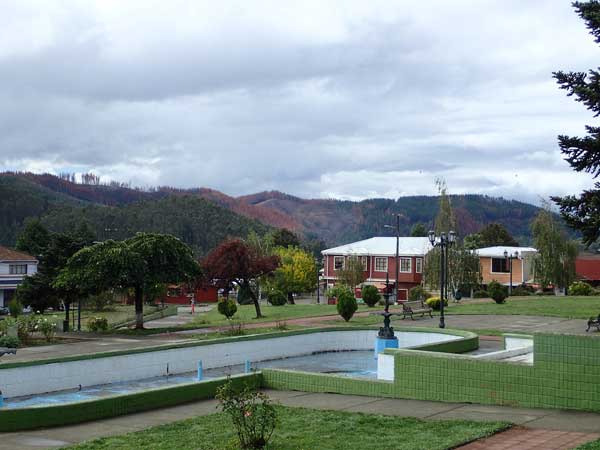 The main square in Capitán Pastene, note the burnt hillside beyond 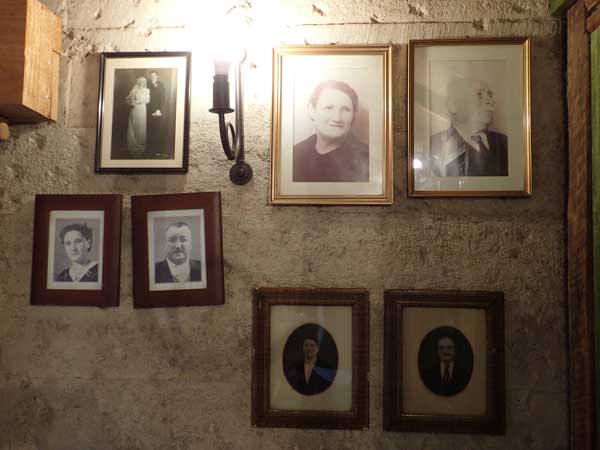 The Ancestors (on the wall in the trattoria) From Temuco we caught a bus to Valdivia and Joyce checked into the Naguilan Hotel, just a few blocks down from the yacht club. That night we introduced her to pisco sour, the national Chilean drink which she enjoyed. The weather remained dismal, Valdivia isn’t nicknamed ‘Valdilluvia’ for nothing. ‘Lluvia’ means rain in Spanish. We visited the small historical museum which was very good, took a boat trip to Punucapa to see the black necked swans and baked scones for our friends at the yacht club. We caught the night bus back to Santiago and visited Pablo Neruda’s house La Chascona. On our last night together, we went in search of a pisco sour. “Pico what?” asked our waiter. “Never heard of it.” Surely my accent wasn’t that bad, maybe the guy wasn’t Chilean. “Where are you from?” I asked. “From Venezuela.” He replied. We suggested he should find out what a pisco sour was, or else his career in Chile might end prematurely. He is a talented young man, another one fleeing the chaos and misery wrought by ‘President’ Maduro. My mother flew home via London and I caught the night bus back to Valdivia. I got back just two hours before she landed in Geneva. |